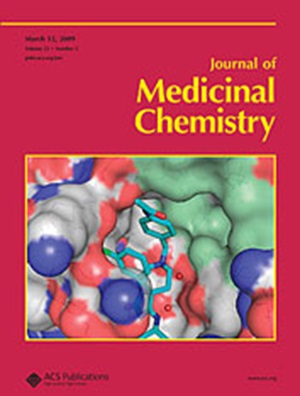5-磺基硫脲嘧啶衍生物拮抗剂与趋化素受体CMKLR1和GPR1的相似结合模式。
IF 6.8
1区 医学
Q1 CHEMISTRY, MEDICINAL
引用次数: 0
摘要
一些研究已经将趋化素/趋化因子样受体1 (CMKLR1)与炎症、白细胞募集和肥胖联系起来。减少细胞活化可以减少脂肪组织的炎症。高通量筛选鉴定出一种新型拮抗剂(VU0514009),并对化合物16进行了优化,使其成为一种完全竞争性拮抗剂(IC50 = 37 μM)。诱变研究阐明了化合物16在CMKLR1残基Y6.51和L7.35以及F7.31、S7.32和T7.39形成结合袋处的相关相互作用。基于活性CMKLR1/chemerin-9结构和非活性AlphaFold模型,在非活性模型中进行了硅对接,化合物16最有可能是正极结合。考虑到CMKLR1与GPR1的序列相似性,化合物16与GPR1对接,表明其结合相似。在GPR1,化合物16对chemerin-9介导的阻滞蛋白募集和内化的影响略低。本文章由计算机程序翻译,如有差异,请以英文原文为准。
Similar Binding Mode of a 5-Sulfonylthiouracil Derivative Antagonist at Chemerin Receptors CMKLR1 and GPR1.
Several studies have linked chemerin/chemokine-like receptor 1 (CMKLR1) to inflammation, leukocyte recruitment, and obesity. Reduced cellular activation may reduce inflammation in adipose tissues. High-throughput screening identified a novel antagonist (VU0514009), which was optimized to compound 16 as a full and competitive antagonist (IC50 = 37 μM). Mutagenesis studies elucidated relevant interactions of compound 16 at CMKLR1 residues Y6.51 and L7.35 as well as F7.31, S7.32, and T7.39 forming the binding pocket. Based on active CMKLR1/chemerin-9 structures and the inactive AlphaFold model, in silico docking was performed in the inactive model, with compound 16 most likely binding orthosterically. Considering the sequence similarity of CMKLR1 and GPR1, compound 16 was docked to GPR1, indicating a similar binding. At GPR1, compound 16 showed a slightly lower effect on chemerin-9-mediated arrestin recruitment and internalization.
求助全文
通过发布文献求助,成功后即可免费获取论文全文。
去求助
来源期刊

Journal of Medicinal Chemistry
医学-医药化学
CiteScore
4.00
自引率
11.00%
发文量
804
审稿时长
1.9 months
期刊介绍:
The Journal of Medicinal Chemistry is a prestigious biweekly peer-reviewed publication that focuses on the multifaceted field of medicinal chemistry. Since its inception in 1959 as the Journal of Medicinal and Pharmaceutical Chemistry, it has evolved to become a cornerstone in the dissemination of research findings related to the design, synthesis, and development of therapeutic agents.
The Journal of Medicinal Chemistry is recognized for its significant impact in the scientific community, as evidenced by its 2022 impact factor of 7.3. This metric reflects the journal's influence and the importance of its content in shaping the future of drug discovery and development. The journal serves as a vital resource for chemists, pharmacologists, and other researchers interested in the molecular mechanisms of drug action and the optimization of therapeutic compounds.
 求助内容:
求助内容: 应助结果提醒方式:
应助结果提醒方式:


